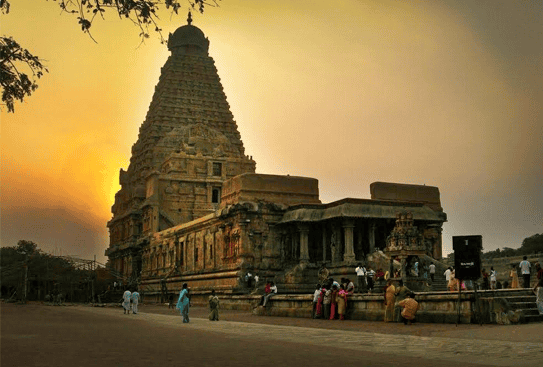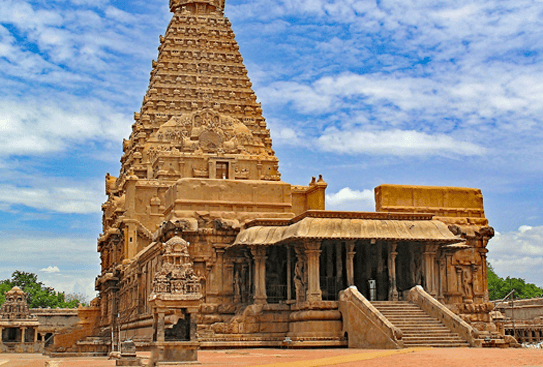Tanjore Temple: History, Architecture, Visiting Hours & Unique Facts
Explore the majestic Tanjore Temple, a UNESCO World Heritage Site showcasing Chola dynasty’s grandeur. Discover its history, unique features, architecture, visiting timings, and pooja sessions for an enriching visit.
What Makes Tanjore Temple Special?
The Tanjore Temple, officially known as Brihadeeswarar Temple, stands as a timeless testament to the ingenuity and devotion of the Chola Empire in South India. Located in Thanjavur (formerly Tanjore), Tamil Nadu, this magnificent structure is dedicated to Lord Shiva and is one of the most revered Hindu temples in the world. Built over a millennium ago, it continues to captivate visitors with its architectural brilliance, historical significance, and spiritual aura. What sets it apart is not just its size but the engineering feats achieved without modern technology, making it a UNESCO World Heritage Site as part of the “Great Living Chola Temples.” This blog delves into the special aspects of the temple, including its history, architecture, unique features, and practical details like visiting timings and pooja sessions.
Spanning an area of about 240 meters east to west and 122 meters north to south, the temple complex is a sprawling marvel that includes multiple shrines, halls, and gateways. It’s often called the “Big Temple” due to its grandeur, and it remains an active place of worship where ancient rituals are performed daily. The temple’s construction reflects the peak of Dravidian architecture, blending art, science, and religion seamlessly. For history buffs, architecture enthusiasts, and spiritual seekers alike, Tanjore Temple offers a profound experience that transports you back to the 11th century.
History of Tanjore Temple
The origins of Tanjore Temple trace back to the Chola emperor Raja Raja I, who commissioned its construction between 1003 and 1010 CE. Raja Raja I, a visionary ruler known for his military conquests and patronage of the arts, built the temple to honor Lord Shiva as Brihadeeswarar, meaning “the Great Lord.” Originally named Rajarajesvaram, it symbolized the Chola dynasty’s power and cultural supremacy. The temple was completed in just seven years, a remarkable feat considering the scale and materials used—primarily granite sourced from over 50 kilometers away.
Over the centuries, the temple has witnessed invasions, renovations, and additions. It was damaged during raids by Muslim sultans in the medieval period but was restored by subsequent Hindu rulers, including the Nayakas and Marathas. Inscriptions on the walls, numbering over 100 in Tamil and Grantha scripts, provide invaluable insights into the era’s society, economy, and administration. These records detail donations, temple staff (including 400 dancers, musicians, and priests), and even daily wages, offering a glimpse into the Chola welfare system. The temple celebrated its 1,000th anniversary in 2010 with grand events, including dance festivals and commemorative stamps, highlighting its enduring legacy.
Today, the temple is managed by the Thanjavur Maratha royal family and continues to be a hub for cultural activities, such as the annual Brahan Natyanjali dance festival during Mahashivratri.
Architectural Wonders of Tanjore Temple
Tanjore Temple exemplifies Dravidian architecture at its finest, characterized by its towering vimana (sanctum tower) that rises to 216 feet (66 meters), making it one of the tallest temple towers in India. The vimana is a 13-tiered pyramid, topped with an 80-ton monolithic granite capstone. Legend has it that this massive stone was hauled up using a ramp of earth, showcasing ancient engineering prowess. The entire structure is built on a raised platform, with symmetrical layouts and axial alignments that align with astronomical events.
The temple’s sanctum houses a colossal Shiva Lingam, standing 8.7 meters tall—one of the largest in India. Surrounding it are intricate carvings depicting mythological scenes, deities, and dancers. The outer walls feature elaborate sculptures, including 81 of the 108 karanas (dance poses) from the Natya Shastra, which have influenced Bharatanatyam. The complex includes a massive Nandi (bull) statue, carved from a single stone weighing 25 tons, facing the sanctum. Fortified walls with gopurams (gateways) adorned with Puranic reliefs add to the defensive and aesthetic elements.
Inside, the temple boasts Chola fresco paintings covering 670 square meters, depicting scenes from Shaivism, Vaishnavism, and daily life. These artworks, discovered in the 20th century, were preserved under layers of later paintings and represent a rare survival of ancient Indian mural art.
Unique Features and Engineering Marvels
What truly makes Tanjore Temple special are its engineering innovations. The vimana casts no shadow at noon due to its precise design, a feat of ancient astronomy. The capstone’s placement without cranes remains a mystery, with theories suggesting inclined planes or elephant-assisted ramps. The temple’s acoustics are exceptional; whispers in one corner can be heard across the hall, possibly for ritualistic purposes.
Another highlight is the underground passages and the massive granite blocks interlocked without mortar, ensuring seismic stability. The inscriptions also reveal a sophisticated administrative system, with the temple employing over 600 people in various roles. During festivals, the temple car (rath) procession, revived in 2015 after a century, draws thousands.
Visiting Timings and Pooja Sessions
Planning a visit? The temple is open daily in two sessions: morning from 6:00 AM to 12:30 PM and evening from 4:00 PM to 8:30 PM. Entry is free, though special poojas may incur fees. Dress modestly—cover shoulders and knees; footwear must be removed.
Pooja sessions follow a traditional schedule:
- Ushakalam (Dawn Pooja): 6:00 AM – Starts with the temple opening, involving initial rituals and abhishekam (sacred bath) for the deity.
- Kaala Sandhi (Morning Pooja): 6:30 AM – Focuses on morning offerings and chants.
- Uchikalam (Noon Pooja): 12:00 PM – Midday rituals before the afternoon closure.
- Sayaratchai (Evening Pooja): 5:00 PM – Evening worship with lamps and aarti.
- Irandam Kalam (Second Evening Pooja): 7:00 PM – Additional evening session.
- Ardha Jamam (Night Pooja): 8:30 PM – Concluding rituals before closing, often the most serene.
Timings may vary during festivals like Mahashivratri or the annual chariot festival. Early mornings are ideal for fewer crowds and witnessing sunrise rituals. Weekdays are less busy than weekends.
Best Time to Visit and Tips
The best season is winter (October to March) when temperatures are mild (20-30°C), perfect for exploring the outdoor complex. Avoid summers due to heat. For a spiritual immersion, attend during pooja times or festivals.
Tips: Hire a guide for insights into inscriptions; photography is allowed outside the sanctum but not inside. Combine your visit with nearby Chola temples for a full heritage tour.
In conclusion, Tanjore Temple’s blend of history, art, and spirituality makes it an unparalleled wonder. Whether you’re admiring the vimana or participating in a pooja, it leaves an indelible mark.
Smart Holidays – Tours & Cab Services Coimbatore
Smart Holidays Coimbatore offers reliable travel solutions in partnership with Urbania Rental to meet all your transportation and tour needs. Whether you’re planning a family trip in an Innova Crysta, organizing a group journey in a 15-seater Force Tempo traveller, or need smooth airport or business transfers, they deliver safe, on-time, hassle-free service. Their fleet is well-maintained and driven by professionals to ensure comfort throughout your trip. From temple tours around South India to local sightseeing and corporate travel, they tailor packages to your preferences. Affordable rates, clear terms, and memorable experiences—book with Smart Holidays & Urbania Rental today!



Leave a Comment: